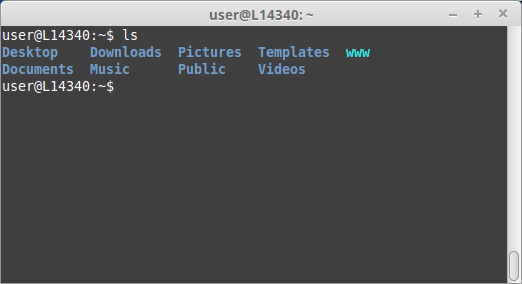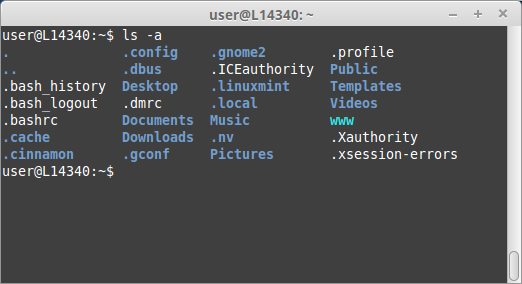UNIX Tutorial One
1.1 Listing files and directories
ls (list)
When you first start the terminal, your current working directory is your home directory. Your home directory has the same name as your user-name, for example, spragunr, and it is where your personal files and subdirectories are saved.
To find out what is in your home directory, type
$ ls
The ls command ( lowercase L and lowercase S ) lists the contents of your current working directory.

ls does not list files with names that begin with a dot (.) Files beginning with a dot (.) are known as hidden files and usually contain program configuration information. They are hidden because you should not change them unless you are very familiar with UNIX!!!
To list all files in your home directory including those whose names begin with a dot, type
$ ls -a
As you can see, ls -a lists files that are normally hidden.

ls is an example of a command which can take options: -a is an example of an option. The options change the behaviour of the command. There are online manual pages that tell you which options a particular command can take, and how each option modifies the behaviour of the command. (See later in this tutorial)
1.2 Making Directories
mkdir (make directory)
We will now make a subdirectory in your home directory to hold the files you will be creating and using in the course of this tutorial. To make a subdirectory called unixstuff in your current working directory type
$ mkdir unixstuff
To see the directory you have just created, type
$ ls
1.3 Changing to a different directory
cd (change directory)
The command cd directory means change the current working directory to 'directory'. The current working directory may be thought of as the directory you are in, i.e. your current position in the file-system tree.
To change to the directory you have just made, type
$ cd unixstuff
Type ls to see the contents (which should be empty)
Exercise 1a
Make another directory inside the unixstuff directory called backups
1.4 The directories . and ..
Still in the unixstuff directory, type
$ ls -a
As you can see, in the unixstuff directory (and in all other directories), there are two special directories called (.) and (..)
The current directory (.)
In UNIX, (.) means the current directory, so typing
$ cd .
NOTE: there is a space between cd and the dot
means stay where you are (the unixstuff directory).
This may not seem very useful at first, but using (.) as the name of the current directory will save a lot of typing, as we shall see later in the tutorial.
The parent directory (..)
(..) means the parent of the current directory, so typing
$ cd ..
will take you one directory up the hierarchy (back to your home directory). Try it now.
Note: typing cd with no argument always returns you to your home directory. This is very useful if you are lost in the file system.
1.5 Printing Your Working Directory
pwd (print working directory)
To find out the absolute pathname of your home-directory, type cd to get back to your home-directory and then type
$ pwd
The full pathname will look something like this:
/cs/home/stu/user
which means that user (your home directory) is in the sub-directory stu, which in turn is located in the home sub-directory, which is in the cs sub-directory, which is in the top-level root directory called " / " .
Exercise 1b
Use the commands cd, ls and pwd to explore the file system.
(Remember, if you get lost, type cd by itself to return to your home-directory)
1.6 Command History
The terminal keeps track of the commands you have recently entered. Use the up arrow to recall the previous command you wrote, and press enter to run it again. Now press up several times to go back several commands, followed by the down arrow to move forward to more recent commands.
1.7 More about home directories and pathnames
Understanding pathnames
First type cd to get back to your home-directory, then type
$ ls unixstuff
to list the conents of your unixstuff directory.
Now type
$ ls backups
You will get a message like this -
backups: No such file or directory
The reason is, backups is not in your current working directory. To use a command on a file (or directory) not in the current working directory (the directory you are currently in), you have three options:
-
You can use the relative path name:
$ ls unixstuff/backups
-
You can use the absolute path:
$ ls /cs/home/stu/user/unixstuff/backups
-
Or you can cd to the directory containing backups:
$ cd unixstuff
$ ls backups
~ (your home directory)
Home directories can also be referred to by the tilde ~ character. It can be used to specify paths starting at your home directory. So typing
$ ls ~/unixstuff
will list the contents of your unixstuff directory, no matter where you currently are in the file system.
What do you think
$ ls ~
would list?
What do you think
$ ls ~/..
would list?
1.8 Tab Completion
When working in the command line, you can often avoid some typing by using the Tab key to complete partially entered commands. For example, type the following (without pressing enter) and then press tab.
$ ls ~/un
The terminal should complete "unixstuff" for you.
Try typing the following command with as few keystrokes as possible. (Hint: Use the tab key sometime after every slash.)
ls /usr/share/info/
Summary
| Command | Meaning |
|---|---|
| ls | list files and directories |
| ls -a | list all files and directories |
| mkdir | make a directory |
| cd directory | change to named directory |
| cd | change to home-directory |
| cd ~ | change to home-directory |
| cd .. | change to parent directory |
| pwd | display the path of the current directory |
M.Stonebank@surrey.ac.uk, © 9th October 2000